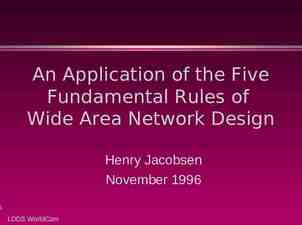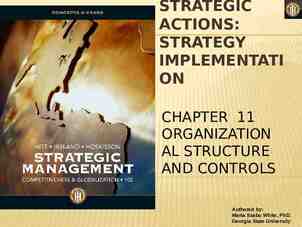Brigade Command & Battle Staff Training MILITARY DECISION
43 Slides462.50 KB

Brigade Command & Battle Staff Training MILITARY DECISION MAKING PROCESS Combined Arms . . . Decisive Victory MDMP 1

Brigade Command & Battle Staff Training Military Decision Making Process MISSION RECEIVED CDR ACTIONS STAFF ACTIONS INFO TO CDR STAFF EST INFO TO STAFF MSN ANALYSIS RESTATED MSN CDR’S GUIDANCE MISSION ANALYSIS PROPOSED RESTATED MSN COA DEVELOPMENT COA DEVELOPMENT/ ANALYSIS COA ANALYSIS, COMPARISON, RECOMMENDATION PREP PLAN/ ORDER/FRAGO COA COMPARISON AND DECISION ISSUE PLAN/ ORDER/FRAGO CDR’S EST PLAN/ORDER/ FRAGO APPROVAL MSN REC’D BY SUB UNITS EXECUTION Combined Arms . . . Decisive Victory MDMP 2

Brigade Command & Battle Staff Training Military Decision Making Process RECEIPT OF MISSION WARNING ORDER MISSION ANALYSIS WARNING ORDER COA DEVELOPMENT COA ANALYSIS COA COMPARISON COA APPROVAL WARNING ORDER ORDERS PRODUCTION REHEARSAL EXECUTION & ASSESSMENT Combined Arms . . . Decisive Victory FM 101-5 pg 5-2 MDMP 3

Brigade Command & Battle Staff Training Military Decision Making Process WARNING ORDER # Copy of Copies References: Issuing headquarters 1. SITUATION Place of issue a. Enemy forces. Date-time group of signature b. Friendly forces. Message reference no. (1) Mission (2) Commander’s Intent c. Attachments and detachments. 2. MISSION 3. EXECUTION Intent (when available). a. Concept of operation (when available). Assembly area locations (If applicable, when available). b. Tasks to maneuver units (when available). (1) Reconnaissance. (2) Surveillance (2) Security c. Tasks to combat support units (when available). d. Coordinating instructions. (1) Earliest movement time and degree of notice. (2) Orders group meeting (attendees, location, and time) (when applicable). 4. SERVICE SUPPORT a. Special equipment. b. Transportation. 5. COMMAND AND SIGNAL ACKNOWLEDGE: NAME (Commander’s last name) RANK (Commander’s rank) OFFICIAL: ANNEXES: DISTRIBUTION: Combined Arms . . . Decisive Victory FM 101-5 pgs H-27/28 MDMP 4

Brigade Command & Battle Staff Training Military Decision Making Process 7 Steps Receipt of mission Mission analysis Course of action development Course of action analysis Course of action comparison Course of action approval Orders production Combined Arms . . . Decisive Victory FM 101-5 pg 5-3 MDMP 5

Brigade Command & Battle Staff Training Military Decision Making Process Step 1 Input Mission of Higher Output Receipt of Mission - Initial Assessment - Update Staff Estimates - Prepare for Mission Analysis Combined Arms . . . Decisive Victory Cdr’s Initial Guidance Warning Order 1 FM 101-5 pgs 5-3, 5-4 MDMP 6

Brigade Command & Battle Staff Training Military Decision Making Process Step 2 Output Input Mission Staff Estimates Facts & Assumptions Mission Analysis - Analysis of Higher Msn/Intent - Identify Specified / Implied Tasks / Essential Tasks - Review Task Org / Assets - Determine Restrictions / Constraints - Assess Risk - Identify Critical Facts / Assumptions Initial IPB Products Restated Mission Cdr’s Intent / Guidance Warning Order 2 Staff Products Battlefield Framework Preliminary Movement Combined Arms . . . Decisive Victory FM 102-5 pgs 5-4, 5-5 MDMP 7

Brigade Command & Battle Staff Training Definition of Commander’s Intent The commander’s intent is a clear, concise statement of what the force must do to succeed with respect to the enemy and the terrain, and the desired end state. It provides the link between the mission and the concept of operations by stating the key tasks that, along with the mission, are the basis for subordinates to exercise initiative when unanticipated opportunities arise or when the original concept of operations no longer applies. Intent is normally expressed in four or five sentences and is mandatory for all orders. The mission and the commander’s intent must be understood two echelons down. Combined Arms . . . Decisive Victory FM 101-5 pg 5-9 MDMP 8

Brigade Command & Battle Staff Training Intent Statement Commander’s intent statement should state the following: – Key tasks – End state Combined Arms . . . Decisive Victory FM 101-5 pg 5-9 MDMP 9

Brigade Command & Battle Staff Training Key Tasks For Commander’s Intent Tasks that must be performed, or conditions that must be met, to achieve stated purpose of the operation Not tied to specific course of action, but fundamental to the force’s success Subordinates use these tasks to keep their efforts supporting the commander’s intent Examples – – – – Tempo Duration Terrain that must be controlled Effect on the enemy Combined Arms . . . Decisive Victory FM 101-5 pg 5-9 MDMP 10

Brigade Command & Battle Staff Training Example Commander’s Intent Mission At 112130JUL97, 1 CAV DIV attacks in zone to PL VIRGINIA to defeat the 61 BDE (MTZD) and establish a covering force NLT 120600JUL97 from PL ALABAMA to PL MAINE to protect CORPS assembly areas. On order, 1 CAV DIV attacks in zone to PL FLORIDA to defeat the remaining enemy forces. On order, defends in sector from PL ILLINOIS to PL VIRGINIA to defeat enemy attacks across the international border. Commander's Intent I want to rapidly defeat the remaining enemy forces in zone to PL ALABAMA to establish a covering force. The covering force will protect the division until we are prepared for combat and facilitate the forward passage of the heavy brigades, allowing the heavy brigades to rapidly defeat enemy forces in zone to PL FLORIDA, and posture the division to destroy any enemy counterattacks across the international border. End state is the international border restored and the division defending in sector along PL FLORIDA prepared to defeat any enemy attacks across the international border. Combined Arms . . . Decisive Victory MDMP 11

Brigade Command & Battle Staff Training Military Decision Making Process – – – – – – – – – – – – – 13 Elements of commander’s guidance Specify COAs, friendly & enemy, and the priority for addressing them The CCIR Reconnaissance guidance Risk guidance Deception guidance Fire support guidance Mobility & countermobility guidance Security measures to be implemented Additional specific priorities for CS and CSS Other information the Cdr wants the staff to consider The time plan Type of order to issue Type of rehearsal to conduct FM 101-5 pg 5-10 Combined Arms . . . Decisive Victory MDMP 12

Brigade Command & Battle Staff Training Commander’s Critical Information Requirements (CCIR) Supports the commander’s battlefield visualization Identifies critical decisions Assists in determining or validating COAs Helps filter information available to the commander Focuses the efforts of subordinates and staff Assists in the allocation of resources Assists staff officers in making recommendations 10 or less items of information Directly affects the success or failure of the mission Combined Arms . . . Decisive Victory FM 101-5 pg 5-7 MDMP 13

Brigade Command & Battle Staff Training Commander’s Critical Information Requirements (CCIR) PIR - Information about the enemy. Example: Are the 14 TMD and 13 ID DAGs located vicinity NAI 17 (CH 4535) and NAI 14 (CH3736) respectively? LTIOV: 252300JUL97 EEFI - Information needed to protect friendly forces from the enemy’s information-gathering systems. Example: Location of brigade command posts. FFIR - Information about the capabilities of own or adjacent units. Example: First contact with enemy. Combat power below designated level. Combined Arms . . . Decisive Victory FM 101-5 pg 5-8 MDMP 14

Brigade Command & Battle Staff Training NCOs In The Military Decision Making Process PLANNING PROCESS MISSION ANALYSIS –Prepare charts for mission analysis –Prepare terrain sketches –Update and post unit reports/status –Prepare TOC for planning process –Conduct mission analysis –Serve as a recorder during process –Brief commander and staff COMMANDER’S GUIDANCE –Assist Cdr in developing guidance –Issue guidance –Record/post Cdr’s guidance COA DEVELOPMENT –Prepare charts –Sketch COAs –Develop COAs COMMANDER X STAFF OFFICERS STAFF NCOs X X X X X X X X X X X RTOs/CLERKS X X X X X X X X X X X Combined Arms . . . Decisive Victory X FM 101-5 pg K-2 MDMP 15

Brigade Command & Battle Staff Training NCOs In The Military Decision Making Process (continued) PLANNING PROCESS COA ANALYSIS –Collect and prepare tools/charts –Serve as a war-game recorder –Conduct war-game session DECISION –Make recommendation to Cdr –Decide –Record/post Cdr’s guidance ORDERS PREP –Write annexes –Consolidate annexes –Type order –Reproduce orders/graphics –Review order –Approve order COMMANDER X STAFF OFFICERS STAFF NCOs X X X X X X X X X X X RTOs/CLERKS X X X X X X Combined Arms . . . Decisive Victory X X X X X FM 101-5 pg K-2 MDMP 16

Brigade Command & Battle Staff Training MILITARY DECISION MAKING PROCESS Workshop #2 Combined Arms . . . Decisive Victory MDMP 17

Brigade Command & Battle Staff Training Military Decision Making Process Step 3 Input Restated Mission Cdr's Guidance / Intent Staff Estimates Enemy COAs Output Course of Action Development - COA Stmts / Sketches Analyze Relative Combat Power Generate Options Array Initial Forces Develop the Scheme of Maneuver Assign Headquarters Prepare COA Statements / Sketches Combined Arms . . . Decisive Victory FM 101-5 pgs 5-4, 5-11 MDMP 18

Brigade Command & Battle Staff Training Course of Action Development Criteria Suitability Feasibility Acceptability Distinguishability Completeness Combined Arms . . . Decisive Victory FM 101-5 pg 5-11 MDMP 19

COA #1 Brigade Command & Battle Staff Training LOA (PL WISCONSIN) 37 CFL 52 DIV 200100 MAY 97 42 OBJ SABER CFL 52 DIV 200100 MAY 97 LOA (PL WISCONSIN) TONG’DUCH O/O FEBA (PL FLORIDA) OBJ KNIFE PL IOWA AA SCABBARD PL IOWA PL NEBRASKA PL NEBRASKA 3 X 1 LD/LC (PL NEVADA) OBJ BAYONET O/O FEBA (PL FLORIDA) X 52 ID X MNC X LD/LC (PL NEVADA) 57 03 Course of Action: BDE attacks frontally with two task forces abreast at 200630 May 97 with a mech heavy task force conducting the main attack in zone in the east to seize OBJ BAYONET to defeat an enemy battalion. Priority of indirect fires initially to counterbattery then neutralization of enemy forces at the point of attack. Smoke will be used to isolate enemy positions at the point of attack. A 20 minute prep on the OBJ’s will be fired to suppress enemy forces. An infantry battalion conducts a supporting attack in zone in the west to seize OBJ KNIFE to defeat an enemy battalion. A tank heavy task force follows the mech heavy task force and assumes the main effort to defeat the second echelon battalion vicinity OBJ SABER. Lead battalions provide frontal and flank security. A mech team, brigade reserve, follows the tank heavy task force prepared to reinforce the main effort or respond to threats to LOC. DS, R artillery and Q36 radar will initially position forward along PL NEVADA. One battery from the DS and one battery from the R battalion will initially move behind the lead Co/Tm’s in the right and left zone, respectively. The Q36 radar will move with the mech heavy TF. BDE Main CP will position NEVADA prior to attack. TAC CP will follow mech heavy TF. Combined Armsvic . .PL. Decisive Victory MDMP 20 Risk is accepted by having a small reserve in order to mass combat power on the objective.

COA #1 Brigade Command & Battle Staff Training LOA (PL WISCONSIN) 37 CFL 52 DIV O/O CFL 52 DIV O/O 42 LOA (PL WISCONSIN) TONG’DUCH FEBA (PL FLORIDA) FEBA (PL FLORIDA) X TAC PL IOWA PL IOWA X EA AUSTIN MAIN AA SCABBARD PL NEBRASKA PL NEBRASKA 3 X 1 PL NEVADA EA DALLAS AA HILT X 52 ID X MNC X PL NEVADA 57 03 Course of Action: On order, BDE defends from PL FLORIDA to PL NEVADA with two task forces abreast to defeat the advance guard and lead battalions; a task force in depth, the defeat mechanism, will counter attack to defeat the enemy. Forward battalions establish screen from PL WISCONSIN to PL FLORIDA. The tank heavy task force establishes a combat outpost in TONG’DUCH to engage enemy reconnaissance and force deployment of the Advanced Guard Battalion. Indirect fires neutralize Advance Guard in security zone. A tank heavy task force, main effort, in the east defends in sector from PL FLORIDA to PL IOWA to defeat the advance guard and first echelon battalion. An infantry battalion in the west defends in sector from PL FLORIDA to PL IOWA to defeat a first echelon battalion. A mech heavy task force occupies AA SCABBARD; on order main effort counterattacks into EA DALLAS or EA AUSTIN to defeat the second echelon battalion. Priority of fires to main effort battalion. Use blocking obstacles to shape EA DALLAS or EA AUSTIN once enemy main effort is identified, to support mech heavy TF’s CATK. A mech team, brigade reserve, occupies AA HILT, prepared to defeat penetrations of PL NEBRASKA or respond to level II rear area threats. DS and R artillery with Q36 radar positioned forward between PL FLORIDA and PL IOWA.Arms Risk is .accepted by having aVictory small reserve in order to defeat penetrations of Combined . . Decisive MDMP 21

COA #1 Brigade Command & Battle Staff Training LOA (PL WISCONSIN) 37 CFL 52 DIV 200100 MAY 97 42 OBJ SABER CFL 52 DIV 200100 MAY 97 LOA (PL WISCONSIN) TONG’DUCH O/O FEBA (PL FLORIDA) OBJ KNIFE PL IOWA AA SCABBARD PL IOWA PL NEBRASKA PL NEBRASKA 3 X 1 LD/LC (PL NEVADA) OBJ BAYONET O/O FEBA (PL FLORIDA) X 52 ID X MNC X LD/LC (PL NEVADA) 57 03 Course of Action: BDE attacks frontally with two task forces abreast at 200630 May 97 with a mech heavy task force conducting the main attack in zone in the east to seize OBJ BAYONET to defeat an enemy battalion. Priority of indirect fires initially to counterbattery then neutralization of enemy forces at the point of attack. Smoke will be used to isolate enemy positions at the point of attack. A 20 minute prep on the OBJ’s will be fired to suppress enemy forces. An infantry battalion conducts a supporting attack in zone in the west to seize OBJ KNIFE to defeat an enemy battalion. A tank heavy task force follows the mech heavy task force and assumes the main effort to defeat the second echelon battalion vicinity OBJ SABER. Lead battalions provide frontal and flank security. A mech team, brigade reserve, follows the tank heavy task force prepared to reinforce the main effort or respond to threats to LOC. DS, R artillery and Q36 radar will initially position forward along PL NEVADA. One battery from the DS and one battery from the R battalion will initially move behind the lead Co/Tm’s in the right and left zone, respectively. The Q36 radar will move with the mech heavy TF. BDE Main CP will position NEVADA prior to attack. TAC CP will follow mech heavy TF. Combined Armsvic . .PL. Decisive Victory MDMP 22 Risk is accepted by having a small reserve in order to mass combat power on the objective.

Brigade Command & Battle Staff Training MILITARY DECISION MAKING PROCESS Workshop #3 Combined Arms . . . Decisive Victory MDMP 23

Brigade Command & Battle Staff Training Military Decision Making Process Step 4 Input Output Enemy COA Course of Action Analysis COA Stmts / Sketches - Conduct War Game Staff COA War Game Results Task Organization Mission to Subordinates CCIR Combined Arms . . . Decisive Victory FM 101-5 pgs 5-4, 5-16 MDMP 24

Brigade Command & Battle Staff Training Course of Action Analysis War Gaming Rules Remain unbiased List advantages and disadvantages (as found) Continually assess COA feasibility, acceptability, and suitability Avoid drawing premature conclusions and gathering facts to support such conclusions Compare COAs during comparison process: Not during war game Combined Arms . . . Decisive Victory FM 101-5 pg 5-16 MDMP 25

Brigade Command & Battle Staff Training Course of Action Analysis War Gaming Steps Gather the tools War game the battle and assess the results List all friendly forces List assumptions List known critical events and decision points Determine evaluation criteria Select the war game method (avenue/belt/box) Select method to record and display results (synch matrix or sketch note) Combined Arms . . . Decisive Victory FM 101-5 pg 5-17 MDMP 26

Brigade Command & Battle Staff Training Course of Action Analysis War Game Results 1 OF 3 Modified COA Modified location and timing of the decisive point Identification of key terrain Refinement of enemy event template & matrix Refinement of task organization Identification of subordinate unit’s tasks Allocation of combat, CS and CSS assets to subordinates The synchronization matrix and decision support template Estimate duration of each critical event / entire operation Projection of enemy force destruction Identification of location and commitment of reserve Combined Arms . . . Decisive Victory FM 101-5 pgs 5-23, 5-24 MDMP 27

Brigade Command & Battle Staff Training Course of Action Analysis War Game Results 2 OF 3 Identify likely times and areas for enemy use of WMD and friendly NBC requirements Most dangerous enemy COA Location of commander and CPs Identify additional critical events Identify additional CS and CSS requirements Requirements for deception and surprise Refined C2 requirements Finalize CCIR and IR with LTIOV Finalize R&S plan Refined CCIR and incorporate into R&S plan and graphics Combined Arms . . . Decisive Victory FM 101-5 pgs 5-23, 5-24 MDMP 28

Brigade Command & Battle Staff Training Course of Action Analysis War Game Results 3 OF 3 Develop FS, Engr, AD, IO, CSS plans and graphics Identify / confirm DPs / NAIs, TAIs Timing of force concentration & initiation of the attack or counterattack Develop the intel collection and dissemination plan Determine movement times and tables Identify, analyze, and evaluate strengths and weaknesses of the COA Integrate targeting process Synchronize smoke Identify additional risks, develop control measures Combined Arms . . . Decisive Victory FM 101-5 pgs 5-23, 5-24 MDMP 29

Brigade Command & Battle Staff Training Military Decision Making Process Step 5 Output Input War Game Results Establish Criteria Course of Action Comparison Decision Matrix - Assess Risk - Compare COAs - Recommendation Combined Arms . . . Decisive Victory FM 101-5 pgs 5-4, 5-24 MDMP 30

Brigade Command & Battle Staff Training Course of Action Comparison Select comparison method Determine decision criteria Assign weighting values to criteria Make recommendation Combined Arms . . . Decisive Victory FM 101-5 pg 5-24 MDMP 31

Brigade Command & Battle Staff Training MILITARY DECISION MAKING PROCESS Workshop #4 Combined Arms . . . Decisive Victory MDMP 32

Brigade Command & Battle Staff Training “If the band played a piece first with the piccolo then with the brass horn, then with the clarinet, and then with the trumpet, there would be a hell of a lot of noise but no music. To get harmony in the music, each instrument must support the others, to get harmony in battle, each weapon must support the others. Team play wins.” General George S. Patton Combined Arms . . . Decisive Victory MDMP 33

Brigade Command & Battle Staff Training Orders “There is a type of staff officer who seems to think that it is more important to draft immaculate orders than to get out a reasonably well-worded order in time for action to be taken before the situation changes or the opportunity passes.” BH Liddell Hart Thoughts on War 1933 Combined Arms . . . Decisive Victory MDMP 34

Brigade Command & Battle Staff Training Military Decision Making Process Step 6 Output Input Decision Matrix Course of Action Approval Approved COA - Select COA - Assess Risk - Specify Type of Order Refined Cdr’s Intent Specified Type of Order / Rehearsal High Pay-Off Target List Warning Order 3 Combined Arms . . . Decisive Victory FM 101-5 pgs 5-4, 5-26 MDMP 35

Brigade Command & Battle Staff Training OPORD / OPLAN Development Guidelines / Characteristics 1 OF 2 Address critical facts and assumptions Authoritative expression Positive expression Avoiding unqualified directives Balance Simplicity Be concise Clarity Completeness Combined Arms . . . Decisive Victory FM 101-5 pgs H-3, H-4 MDMP 36

Brigade Command & Battle Staff Training OPORD / OPLAN Development Guidelines / Characteristics 2 OF 2 Coordination Flexibility Clear, concise mission and intent statements Centralized planning Decentralized execution Use of existing resources Timeliness Combined Arms . . . Decisive Victory FM 101-5 pgs H-3, H-4 MDMP 37

Brigade Command & Battle Staff Training Military Decision Making Process Step 7 Input Approved COA Output Orders Production - OPORD / OPLAN Translate into Plan / Order Incorporate Branches and Sequels Establish Control Measures Synchronize Plan / Order Combined Arms . . . Decisive Victory FM 101-5 pgs 5-4, 5-26 MDMP 38

Brigade Command & Battle Staff Training NCOs In TOC OPS TOC FUNCTION XO RECEIVE INFORMATION –Monitor situation –Receive messages/reports –Maintain journal –Update post unit locations –Update status boards/charts DISTRIBUTE INFORMATION –Submit reports –Publish orders –Pass messages/reports within TOCs ANALYZE INFORMATION –Review in/out going reports/orders –Conduct predictive analysis –Identify CCIR –Conduct TDMP –Serve as recorders –Develop terrain Sketches –prepare charts and overlays X BATTLE CPT STAFF NCOs RTOs/CLERKS X X X X X X X X X X X X X X X X X X X X X X X X X X X X X X X MAKE RECOMMENDATIONS TO CDR X X X INTEGRATE/SYNCH RESOURCES X X X X X X X Reference: CALL Newsletter 95-12, DEC 95, Tactical Decision Making: Abbreviated Planning Combined Arms . . . Decisive Victory MDMP 39

Brigade Command & Battle Staff Training NCO Use NCOs involvement Enforce duties and responsibilities Battlestaff trained NCOs Combined Arms . . . Decisive Victory MDMP 40

Brigade Command & Battle Staff Training Military Decision Making Process Rehearsal - 5 Types of Rehearsals - Confirmation Brief - Backbrief - Combined Arms Rehearsal - Support Rehearsal - Battle Drill or SOP Rehearsal Combined Arms . . . Decisive Victory FM 101-5 pgs 5-2, G-1/2 MDMP 41

Brigade Command & Battle Staff Training Military Decision Making Process Execution & Assessment Combined Arms . . . Decisive Victory FM 101-5 pg 5-2 MDMP 42

Brigade Command & Battle Staff Training MILITARY DECISION MAKING PROCESS Combined Arms . . . Decisive Victory MDMP 44






